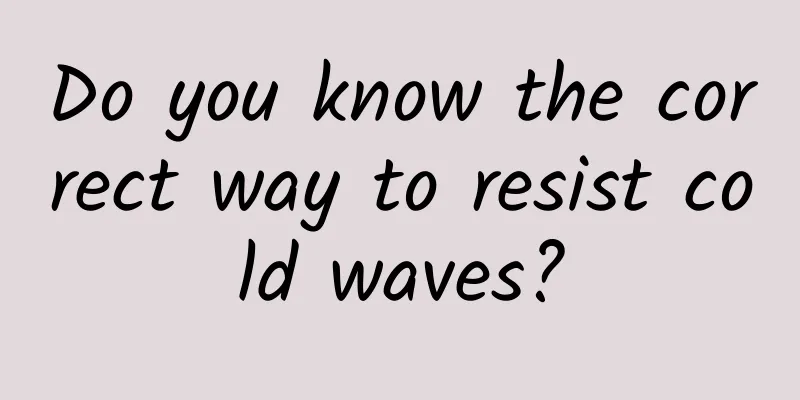Do you know the correct way to resist cold waves?

|
The Tianlan Youfang column is a knowledge sharing section jointly planned and co-created by Tianlan and the Air-Climate-Health Integrated Research Program and Exchange Platform (ARCH). Through interesting scientific knowledge, it helps individuals protect their health and take positive governance actions to deal with air pollution and climate change. This professional content is contributed by the Environmental Health Research Team of Peking University. Author of this article/ Ai Siqi Li Fangzhou The strongest cold wave since the beginning of winter this year has arrived. Are you shivering already? In the recently popular TV series "Sanyue Gets a New Job", there is a funny and realistic plot. Yanan, a senior funeral practitioner, explains to her new female colleague Sanyue what "year-end sadness" means - Pay attention to the lines in the play. Source/Bilibili When it comes to the "hard" winter, we have to mention the "winter killer" cold wave. As early as October 2 this year, the Central Meteorological Observatory issued a blue warning for cold waves. The cold air mass from Siberia moved southward and directly reached the Nanling Mountains. The temperature drop was mainly concentrated in the northeast and central and eastern regions, and the temperature drop in Inner Mongolia and other places was as high as 18℃ or more. This year's subtropical high was particularly strong and lasted for a long time, causing the cold wave to occur when the heat wave was still raging in the south, presenting a situation of confrontation between cold and warm air masses, a strange phenomenon of " quick freezing in the north and hot heat in the south ". Cold wave and high temperature warnings were issued on October 3! Source: Central Meteorological Observatory This is the earliest cold wave warning issued in the second half of the year since 2010 (when the Central Meteorological Observatory officially started the warning release mechanism), and it is also the first time that cold wave and high temperature warnings are issued at the same time!!! People often confuse the concepts of cold air and cold wave. In fact, cold air and cold wave are not the same thing . Cold wave refers to the drastic temperature drop caused by large-scale invasion of high-latitude cold air into low-latitude areas, which usually occurs in late November and early January. 💨The national standard "Cold Air Level" stipulates that when cold air activity causes the minimum daily temperature in a certain place to drop by 8℃ or more within 24 hours, or by 10℃ or more within 48 hours, or by 12℃ or more within 72 hours, and the minimum daily temperature is ≤4℃, it can be called a cold wave. This year, in addition to the abnormal weather signals of high temperature heat waves, cold waves that arrived earlier than in previous years, and the simultaneous occurrence of cold wave and high temperature warnings, the World Meteorological Organization (WMO) predicts that the La Niña phenomenon that began in September 2020 may continue until the winter of 2023, becoming the first La Niña event this century to occur for three consecutive years. As an important driving factor of global temperature change, La Niña describes a large-scale cooling of the surface temperature in the central and eastern equatorial Pacific. Its impact on weather and climate is often opposite to that of El Niño. The two are collectively referred to as ENSO and have an important impact on the global climate. The impact of La Nina events on global climate Source: National Climate Center La Nina often means a cold winter this year, but in the context of global warming, the frequency of warm winters in La Nina events has increased significantly since 1986. For example, last year's 2020/2021 winter was a La Nina year, and even though there were extreme cold waves, it was still a warm winter overall. But judging from the temperature data of the past few decades, we are experiencing a climate trend of getting colder when it's cold and hotter when it's hot. Equatorial Pacific Ocean temperature anomaly source/https://www.climate.gov/ Cold wave weather is usually accompanied by a sharp drop in temperature in a short period of time, which stimulates the human body's sympathetic nerve excitement, causing vasoconstriction, slowed blood flow and thrombosis, aggravating various cardiovascular and cerebrovascular diseases such as hypertension, coronary heart disease, stroke, and even causing sudden death. Cold air can also directly stimulate the respiratory mucosa, reducing secretions and hindering the ability of cilia to clear pathogens, thereby reducing its barrier protection capacity and inducing respiratory infections (common colds, influenza), pneumonia, asthma (especially childhood asthma), and aggravating chronic obstructive pulmonary disease. A study based on 272 cities in China found that exposure to excessively low or high outdoor temperatures (with 22.8°C as the boundary) would significantly increase the risk of non-accidental death (such as stroke and chronic obstructive pulmonary disease), and that the "lethal effect" of low temperatures was stronger than that of high temperatures. The influenza virus invades the human body, parasitizes in the cells and increases in number. Cough, cough, I feel like I have a cold... Image source: "Cells at Work!" The risk of death caused by cold waves varies in different regions, different climate zones, and even different communities in the same city. The relevant influencing factors involve socioeconomics, medical education, urbanization, and geographical location. For example, in terms of geographical location, Chinese scholars have found that compared with southerners, northern residents have a lower mortality rate related to cold waves, or are more "cold-resistant." This may be related to the fact that northern residents have a certain adaptability to the low temperature environment in winter and have taken measures to keep warm (such as continuous heating policies). Therefore, some scholars have called for central heating to not differentiate between the north and the south, and it is imperative to formulate cold wave warning standards that are tailored to local conditions. The number of excess deaths caused by the cold wave in 2018 in the north and south (darker colors mean more deaths) Source: Lei et al., 2022 In addition, cold waves often bring natural disasters such as blizzards, which increase the risk of road traffic accidents and easily cause direct injuries to outdoor workers, such as construction workers, sanitation workers and high-altitude workers, such as frostbite, falls, and falls from heights. To this end, the Canadian Ministry of Environment and Climate Change has comprehensively considered wind speed and temperature indicators and compiled a "wind chill index" that can reflect the perceived temperature to guide workers to take corresponding cold-resistant measures according to the "wind chill level". Wind chill index (darker colors mean lower perceived temperatures) Source: https://www.ccohs.ca/ To resist the cold wave, it requires joint emergency response by multiple departments including government, meteorology, transportation, agriculture, etc., and they should attach great importance to it and carry out various defense work in a timely manner. References: Chen R, Yin P, Wang L, Liu C, Niu Y, Wang W, et al. Association between ambient temperature and mortality risk and burden: time series study in 272 main Chinese cities. BMJ 2018; 363: k4306. Gasparrini A, Guo Y, Hashizume M, Lavigne E, Zanobetti A, Schwartz J, et al. Mortality risk attributable to high and low ambient temperature: a multicountry observational study. The Lancet 2015; 386: 369-375. Lei J, Chen R, Yin P, Meng X, Zhang L, Liu C, et al. Association between Cold Spells and Mortality Risk and Burden: A Nationwide Study in China. 2022; 130: 027006. Sun Q, Sun Z, Chen C, Yan M, Zhong Y, Huang Z, et al. Health risks and economic losses from cold spells in China. Science of The Total Environment 2022; 821: 153478. Please indicate the source when reprinting |
<<: Popular Science Illustrations | What does a better lithium-ion battery look like?
Recommend
Brand Marketing Competitive Product Research
Marketing is like a war. Only when you know yours...
Dongfeng Honda CR-V also learned from Volkswagen to "burn engine oil", and the official response seems to be a lie
Speaking of burning oil, Volkswagen owners must b...
Where does the "memory sand" that gets into your eyes end up? Except shit, shit...
The sudden sandstorm weather has always required ...
The new Apple MacBook is like this?
Will Apple's next MacBook use fingerprint rec...
Pink pink pink pink...pink attack, are you ready?
The recently released "Barbie" created ...
Why is it so hot this year? Extremely high temperatures and long-term standby in many parts of my country
Recently, the heat wave and hot weather have made...
NFT marketing, the beginning of the brand metaverse?
If a brand wants to explore the metaverse , the m...
The deadline for the automobile dual-credit system is set: the key is to implement the trading mechanism before 2018
In China's parallel policy of "fuel cons...
Li Songwei's 16 Lectures on Cognitive Thinking [Complete]
There are no conventional theories here, only new...
During product iteration, how to use data to drive user growth?
In product iteration aimed at user growth , "...
Sea buckthorn, how to make the desert green and golden?
On October 24, 2024, Wang Jian, senior engineer o...
With so many H5s at the end of the year, why do Alipay and NetEase Cloud Music dominate your circle of friends?
At the end of the year and the beginning of the n...
How to promote and attract traffic in QQ group?
The QQ platform has huge marketing potential, wit...
How many steps are needed to make a leaf?
When you step on the fallen leaves on the road an...









